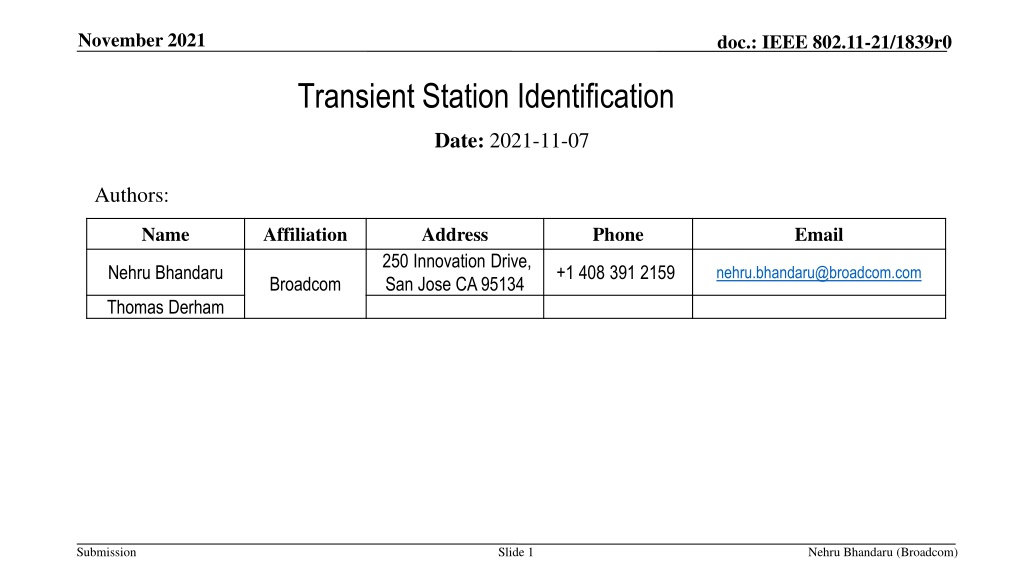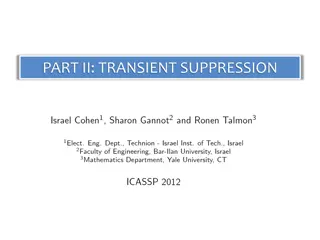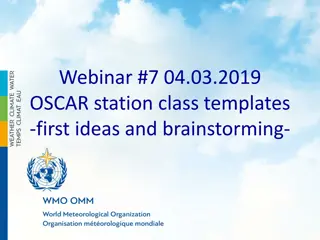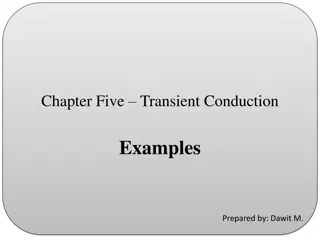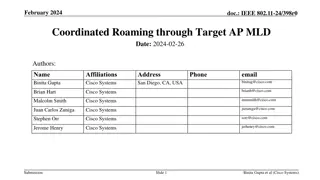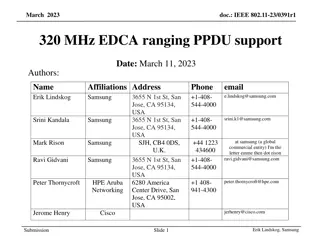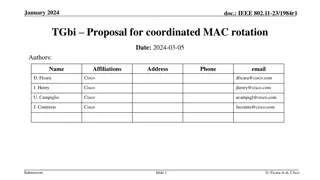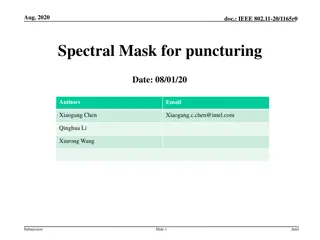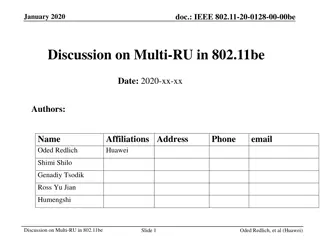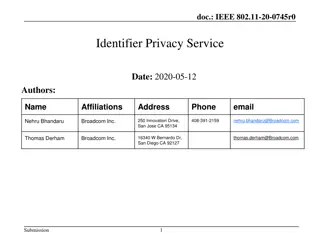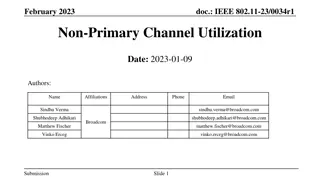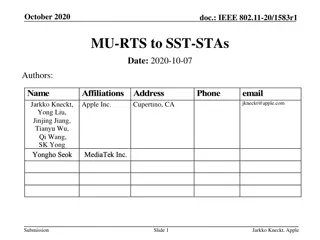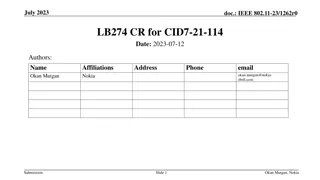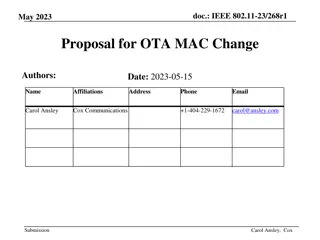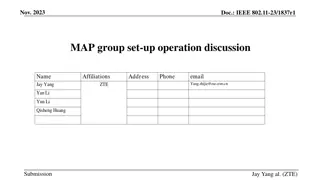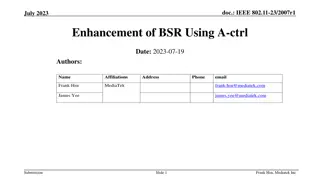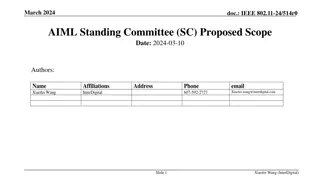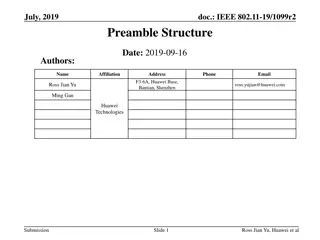Proposal for Transient Station Identification in IEEE 802.11-21
TGbh use cases necessitate a form of Identity for Non-AP STAs for access control. This proposal delves into the concept of a Transient ID, detached from a MAC address, to support use cases securely. It explores the generation and validation of Transient Identity (TSID) and its key (TSIDK) in conjunction with a Security Association, enabling secure identification in wireless networks.
Download Presentation

Please find below an Image/Link to download the presentation.
The content on the website is provided AS IS for your information and personal use only. It may not be sold, licensed, or shared on other websites without obtaining consent from the author. Download presentation by click this link. If you encounter any issues during the download, it is possible that the publisher has removed the file from their server.
E N D
Presentation Transcript
November 2021 doc.: IEEE 802.11-21/1839r0 Transient Station Identification Date: 2021-11-07 Authors: Name Affiliation Address Phone Email 250 Innovation Drive, San Jose CA 95134 Nehru Bhandaru +1 408 391 2159 nehru.bhandaru@broadcom.com Broadcom Thomas Derham Submission Slide 1 Nehru Bhandaru (Broadcom)
November 2021 doc.: IEEE 802.11-21/1839r0 Introduction TGbh use cases need the notion of an Identity Non-AP STA Identity (ID) used for access control e.g., allowed services etc. In general, there can be multiple identities Username, Password ID, Permanent MAC address, Application level Real Identity may only be known to protocol that establishes security e.g., EAP Method Ideally Identity should be bound to security context Several proposals that indicate non-AP STA identity securely to an AP in an Infra network 21/1379 ID query action frames 21/1585 Identifiable Random MAC addresses 21/1083 Signature based identification schemes This proposal explores whether TGbh use cases can be supported with only a transient ID a transient ID that is decoupled from a MAC address that could change any time pre-association or while associated Submission Slide 2 Nehru Bhandaru (Broadcom)
November 2021 doc.: IEEE 802.11-21/1839r0 General Security Considerations Identity is somewhat an abstract notion, can be many For our purposes, we can consider it as opaque e.g., octet string Permanent or Initial MAC address could be used to identify a user/device Non-AP STA Identity needs to be securely conveyed to the Infra AP chicken and egg problem Protecting the conveyance requires a security context Security context setup is based on a notion of Identity Protocols should not reveal Identity RCM for protecting the real/permanent MAC address, for example Asymmetric key signatures (RSA, ECDSA) can leak public keys (see [7] 4.1.6) Should not introduce new trackable identifiers without any security/privacy controls Identity should be bound to the security context Otherwise, there can be misuse e.g., masquerading with replays etc. Excessive computation to determine identity based on RandomizedInformation can lead to (additional) denial of service attacks Submission Slide 3 Nehru Bhandaru (Broadcom)
November 2021 doc.: IEEE 802.11-21/1839r0 Proposal Summary Identity (ID) Opaque, higher layer input Transient Identity (TSID), TSID Key (TSIDK), and TSK Security Association (TSKSA) TSID and TSIDK are cryptographically generated bound to PTKSA, stored in TSKSA TSK Packet Number (TSKPN) for replay protection TSID Validation Using TSID element TSID Update When PTKSA is updated Post association update using SA Query extension Implicit update using TSID element pre or post association Negotiation Support RSNXE Capabilities verified during security association setup Submission Slide 4 Nehru Bhandaru (Broadcom)
November 2021 doc.: IEEE 802.11-21/1839r0 TSID Proposal Create TSID based on PTKSA (similar to rPMKID 11-21-1679) Created and updated every time a PTKSA is created Used by non-AP STA, if desired, to securely identify to the AP During PTKSA creation each side derives the next TSID, TSIDK, TSKPN using IETF RFC5869 TSID-PRK = HKDF-Extract( Transient Station Identity || ID || SA, KDK) TSID = HKDF-Expand(TSID-PRK, TSID , TSID-NBYTES) TSIDK = HKDF-Expand(TSID-PRK, TSIDK , TSIDK-NBYTES) TSKPN = HKDF-Expand(TSID-PRK, TSKPN , 6) // 48-bit random initial packet number TSKSA is updated with TSID, TSIDK and TSKPN HMAC-Hash defined by AKM, TSID-NBITS, TSIDK-NBITS by RSNXE caps TSID/TSIDK can be updated pre-association using PASN PTKSA (11az) KDK is derived when TSID features are enabled Currently derived for WUR (802.11ba) and 802.11az features Submission Slide 5 Nehru Bhandaru (Broadcom)
November 2021 doc.: IEEE 802.11-21/1839r0 TSID Proposal TSID element included in selected frames (re)association request, PASN Authentication, Probe Requests AP uses TSID to lookup the TSKSA AP validates TSID using TSID-Hash and TSIDK for the matched TSKSA RSNA protocols (e.g., 4-way handshake), PASN create new PTKSA and update TSKSA TSIDi TSIDi+1, TSIDKi TSIDKi+1, TSKPNi TSKPNi+1 TSID-Hash is computed as follows TSID-Hash = L(HMAC-Hash(TSIDK, Flags || ++TSKPN || TSID || SA || BSSID), 0, TSID-Hash-NBITS) One octet Flags bit 0 = 0 Identify, 1 = Identify and Update, other bits reserved Flags are not transmitted ID Length Element ID Extension TSKPN TSID TSID-Hash Figure 9-xxx TSID element format Submission Slide 6 Nehru Bhandaru (Broadcom)
November 2021 doc.: IEEE 802.11-21/1839r0 TSID Update TSID update during the lifetime of a PTKSA While associated with security or under PASN (State 1a) TSID can change, but always bound to the security context Non-AP STA updates TSID sending a protected TSID update request at any time TSID = L(HMAC-Hash(TSIDK, ++TSID), 0, TSID-NBITS) Extension to SA Query action category Query, TSID Update (new), Response TSIDK and TSKPN are not changed TSID can be updated with TSID element by setting the Update bit in Flags AP computes one additional hash if identity validation fails If update is validated, updates TSID as above non-AP STA can gracefully change MAC address Send a TSID update Start using the new address Submission Slide 7 Nehru Bhandaru (Broadcom)
November 2021 doc.: IEEE 802.11-21/1839r0 TSID Proposal Replay protection Additional replay counter for replay checks Initial random value to prevent tracking RSNXE capabilities advertise support for TSID parameters 2 bits RSNXE Bits 00 TSID-NBITS(NBYTES) TSIDK-NBITS (NBYTES) No Support TSID-Hash-NBITS (NBYTES) 01 64 (8) 128 (16) 64 (8) 10 64 (8) 256 (32) 128 (16) 11 Reserved, N/A Submission Slide 8 Nehru Bhandaru (Broadcom)
November 2021 doc.: IEEE 802.11-21/1839r0 Protocol Usage Example Submission Slide 9 Nehru Bhandaru (Broadcom)
November 2021 doc.: IEEE 802.11-21/1839r0 TSID Proposal Comparison Previous Proposal(s) TSID Proposal 11-21-1585 Identifiable Random MAC addresses Auto transient ID and key generation/distribution without additional messages Replay protection Binding to address (chain) and security context Better performance with faster validation No check field that can be trackable Leverage Std 802.11 SA query support TSID update implicit and explicit, pre and post association 11-21-1083 Signature based identification schemes Does not use public keys Does not leak identity (public key signatures leak the public key) More efficient 11-21-1379 ID Query Action Frame No (additional) ID exchange is needed But can be used in conjunction to retrieve ID to bind to TSID Uses Std 802.11 SA query support Supports Identity recovery with TSID higher layers can do the mapping Works when there is no association, after first secure association or PASN Submission Slide 10 Nehru Bhandaru (Broadcom)
November 2021 doc.: IEEE 802.11-21/1839r0 TSID Proposal Evaluation Metrics Metric Comment Amount of processing required on client and AP STA:TSID/TSIDK derivation, Hash Computation AP: Lookup PMKSA using TSID, Hash Computation, No iteration computing hashes of all entries. Storage Requirements Storage per STA: TSID(8), TSIDK(16 to 32), and PN(6) = 30 to 46 octets Return to the network and use a different MAC address Yes - TSID identifies the used/device rather than bound to a MAC address User opt-in control Yes - capability negotiation, security context, ID query, SA Query/Update, Optional TSID element inclusion Pre-association support Yes Device/User Identifier provided Yes, transient identifier decoupled from MAC address Third party tracking with RCM No, Protected; STA indicates TSID change before changing/randomizing MAC address Hidden mechanism Not hidden from third parties - presence of TSID IE Requires network encryption No, but relies on 802.11 RSNA and PASN security How strongly is ID bound to the user Very loosely, but ID is bound to TSID/TSIDK generation PII exposure No Network can trust in the ID Yes Post association RCM Yes Submission Slide 11 Nehru Bhandaru (Broadcom)
November 2021 doc.: IEEE 802.11-21/1839r0 Q & A Where does ID come from? EAP Authentication, Password ID, Username, Permanent MAC address, First Association MAC address, email address, or an empty string (anonymous/unknown), Query the user (e.g.,11-21-1379) before TSID generation after PTKSA setup ID can be set via MLME, MAC address can be default Can ID be updated? Outside the scope, but TSID can be updated Can we just use the (random) MAC address instead of TSID AP side validation would be inefficient or cumbersome Graceful transition when MAC address changes - TSID binds old MAC address to new MAC address Can TSID be used more than once? Yes, a replay counter protects against replays Can TSID be omitted, with only the hash sent to the AP? No, AP rejects the request/association AP may require TSID element to be included Non-AP STA may choose to include TSID element or not Is TSID a client identifier No, but it can be mapped to one on AP if non-AP STA provides What happens on failures M4 lost or implicit update fails (e.g., no/lost probe response) TSID will mismatch, next request may be rejected What happens when PMKSA is deleted? TBD Does TSID have to be 64 bits? Should suffice Random MAC address have much higher probability of collision Does TSID leak the key? No, standard RFC 5869 HKDF is used Does the proposal require additional key distribution mechanisms? No, TSIDK is generated as part of PTKSA Can PMKID be used as a transient ID? No, PMKID is trackable, TSID could be used without a PMK separation of concern Does this require PMK caching Not necessary, but there needs to be some security association when non-AP STA comes back to the AP/ESS for validating the ID There may not be a PMKSA with PASN How much storage does it need? Does it scale TSKSA needs 30 to 46 bytes per client How does it work with FT and other AKMs? TBD distribute TSID along w/ TSIDK to R1 key holders? How does it work with multiple APs Distribute TSID and TSIDK? Needs a new TSIDK (derive from TSIDK?) Broadcast probe requests Cannot use TSID update, but can identify Submission Slide 12 Nehru Bhandaru (Broadcom)
November 2021 doc.: IEEE 802.11-21/1839r0 TSID Proposal 1. 2. 3. 4. 5. 6. 7. 8. 9. 10. IETF RFC 5869 HMAC-based Extract and Expand 11-21-0332 TGbh Issues Tracking 11-21-1379 ID Query Action Frame 11-21-1730 Comparison Metrics 11-21-1585 Identifiable Random MAC addresses 11-21-1083 Signature based identification schemes IEEE Std 802.11 -2020 SEC1 Elliptic Curve Cryptography IEEE TGaz Draft 4.0 October 2020 11-21-1697 rPMKID Submission Slide 13 Nehru Bhandaru (Broadcom)
